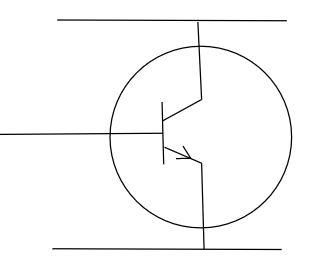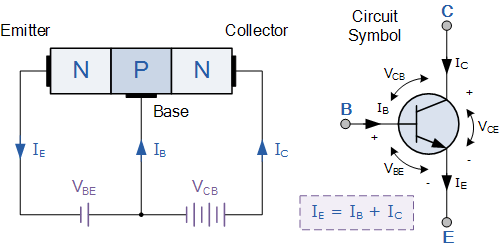
The lead marked with the arrow is the:

A) Collector
B) base
C) emitter
D) Core
Answer
219k+ views
Hint: Transistor is the device that is used as the amplifier and also the switch. It possesses three terminals in it as the base, collector and the emitter. These are made up of the semiconductor in which both PN junction diodes are connected back to back.
Complete step by step solution:
The given diagram represents the $NPN$ (Negative Positive Negative terminal) transistor and the lead marked with the arrow is the emitter. In this the $P$ type semiconductor is placed between the $N$ type semiconductor and the center part in both $PNP$ and the $NPN$ transistors are the same and it is base. The top part in the $NPN$ part is collector. The arrow represents the direction of the movement of the electrons from the emitter and is thick.

The emitter supplies the large negative charged electrons to the collector by the use of the base. Here the positive charge that is moved from the positive terminal to that of the negative terminal and this forms the electric circuit. This type of transistor can be biased in either common base, or common emitter or the common collector mode.
Thus the option (C) is correct.
Note: The $NPN$ transistor is most commonly used than the other types. The base is thin and is placed between the collector and the emitter and it is lightly doped. The very small current is used by the base to work as a switch between the collector and the emitter.
Complete step by step solution:
The given diagram represents the $NPN$ (Negative Positive Negative terminal) transistor and the lead marked with the arrow is the emitter. In this the $P$ type semiconductor is placed between the $N$ type semiconductor and the center part in both $PNP$ and the $NPN$ transistors are the same and it is base. The top part in the $NPN$ part is collector. The arrow represents the direction of the movement of the electrons from the emitter and is thick.

The emitter supplies the large negative charged electrons to the collector by the use of the base. Here the positive charge that is moved from the positive terminal to that of the negative terminal and this forms the electric circuit. This type of transistor can be biased in either common base, or common emitter or the common collector mode.
Thus the option (C) is correct.
Note: The $NPN$ transistor is most commonly used than the other types. The base is thin and is placed between the collector and the emitter and it is lightly doped. The very small current is used by the base to work as a switch between the collector and the emitter.
Recently Updated Pages
A square frame of side 10 cm and a long straight wire class 12 physics JEE_Main

The work done in slowly moving an electron of charge class 12 physics JEE_Main

Two identical charged spheres suspended from a common class 12 physics JEE_Main

According to Bohrs theory the timeaveraged magnetic class 12 physics JEE_Main

ill in the blanks Pure tungsten has A Low resistivity class 12 physics JEE_Main

The value of the resistor RS needed in the DC voltage class 12 physics JEE_Main

Trending doubts
JEE Main 2026: Application Form Open, Exam Dates, Syllabus, Eligibility & Question Papers

Derivation of Equation of Trajectory Explained for Students

Hybridisation in Chemistry – Concept, Types & Applications

Understanding the Angle of Deviation in a Prism

Understanding Collisions: Types and Examples for Students

Understanding Atomic Structure for Beginners

Other Pages
JEE Advanced Marks vs Ranks 2025: Understanding Category-wise Qualifying Marks and Previous Year Cut-offs

How to Convert a Galvanometer into an Ammeter or Voltmeter

Understanding Centrifugal Force in Physics

JEE Main Marking Scheme 2026- Paper-Wise Marks Distribution and Negative Marking Details

Degree of Dissociation: Meaning, Formula, Calculation & Uses

Understanding Electromagnetic Waves and Their Importance




